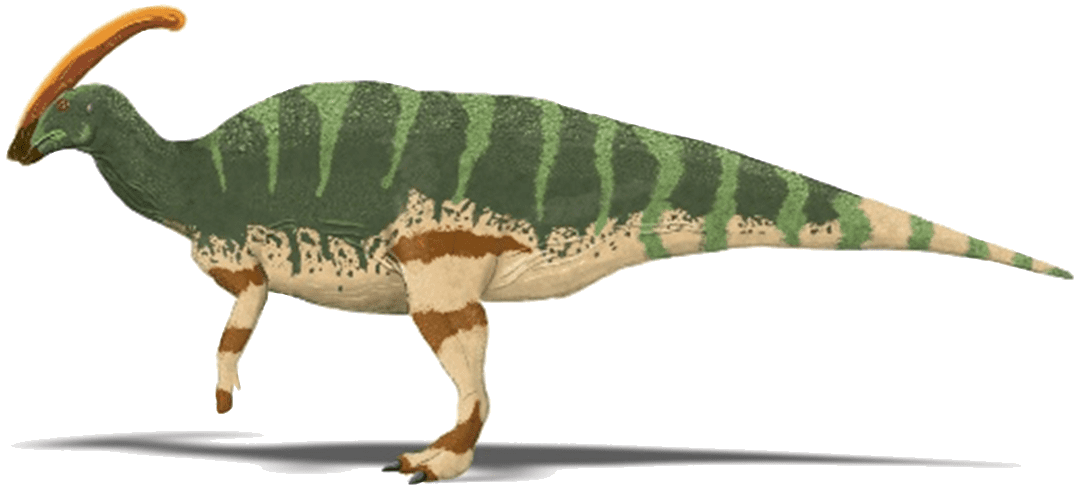25 Most Popular and Famous Dinosaurs: A Comprehensive List
Ah, dinosaurs. Those colossal creatures that once ruled the Earth ignite a spark of wonder in even the most jaded moviegoer or museum visitor.
I mean, the sheer size, fantastical features, and mysterious extinction of these creatures leave us perpetually fascinated. We piece together their lives from fossilized fragments, each bone and claw whispering tales of a world lost to time.
However, even with countless discoveries, much of their existence remains shrouded in the mists of prehistory, fueling our imaginations and yearning for more.
Yet, some of the dinosaurs whose identities are mostly understood, have transcended the realm of scientific curiosity and become etched in popular culture.
From the terrifying Tyrannosaurus Rex, immortalized in Spielberg’s blockbuster Jurassic Park, to the gentle giant Brachiosaurus, towering over museum halls, certain dinosaurs have captured our collective imagination like no others.
Perhaps it’s the way they’ve stomped through the movies we watch, video games we play, and even our (for some) children’s toys, becoming household names recognized by all ages. Or maybe it’s the sheer size and power they represent, a reminder of a time when nature reigned supreme.
Whatever the reason, some of these dinosaurs are undeniable celebrities and, in this article, I will highlight 25 of the most famous dinosaurs exploring their features and lifestyle. Enjoy!
1. Tyrannosaurus rex (T. rex)

J.M. Luijt, CC BY-SA 2.5 NL, via Wikimedia Commons
A member of the Theropod group of dinosaurs, the Tyrannosaurus rex (commonly referred to as the T. rex) is arguably the most famous dinosaur of them all.
This iconic predator reigned supreme over Late Cretaceous North America, roughly 66 million years ago. It also held the title of the largest land carnivore of its time at an average length of 40 feet and weighed up to 8 tons (18000 lbs).
In 1902, renowned fossil hunter Barnum Brown unearthed the first Tyrannosaurus rex skeleton in Hell Creek, Montana, making a significant contribution to the Museum’s collection.
Sure, its arms were laughably small, but its massive head, bone-crushing jaws, and dagger-like teeth made it an apex predator. No creature was safe from this apex predator, thanks in part to the most powerful bite any land animal has ever sported.
Imagine chomping down with the force of 12,000 pounds per square inch – that’s enough to pulverize even the toughest dinosaur bones!
2. Velociraptor
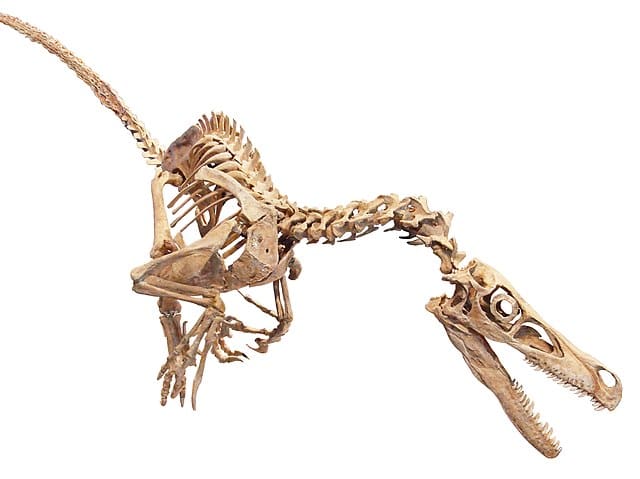
Eduard Solà Vázquez, CC BY 3.0, via Wikimedia Commons
The Jurassic Park movies are mostly the reason why this dinosaur is so famous. However, it should be noted that the movie took creative liberties and the real Velociraptor looked nothing like the one in the movies.
Living about 75 million years ago in what is now Mongolia and China, the Velociraptor was actually a feathered carnivore, about the size of a turkey, weighing around 43 pounds, and only reaching about 2 meters long.
While not quite the movie monster, it still packed a punch with its signature enlarged sickle-shaped claw on its foot, likely used for slashing and grappling prey.
The Velociraptor was a member of a group of dinosaurs known as dromaeosaurs and lived during the Late Cretaceous period, approximately 85 to 70 million years ago.
3. Stegosaurus
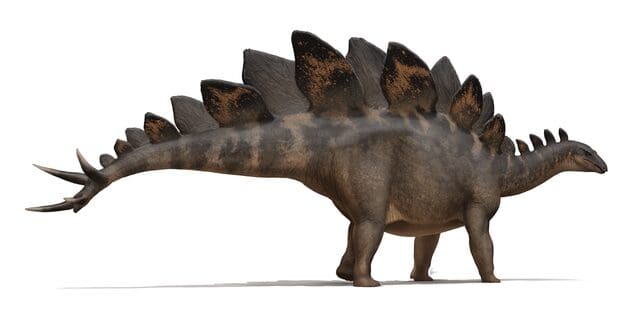
Fred Wierum, CC BY-SA 4.0, via Wikimedia Commons
The Stegosaurus, with its unmistakable double row of bony plates and spiky tail, is a superstar of the dinosaur world. These gentle giants lived during the Late Jurassic (Mesozoic) period, about 155 to 145 million years ago.
This member of the group Thyreophorans was a herbivore munching on plants rather than hunting prey. Despite their fearsome appearance, Stegosaurus didn’t use their plates or spikes for offense, but more likely for defense or temperature regulation.
Fossils of these fascinating creatures have been unearthed primarily in North America, with a few finds in Europe. With over 80 Stegosaurus skeletons discovered so far, paleontologists have been able to piece together a good understanding of their anatomy and lifestyle.
4. Triceratops
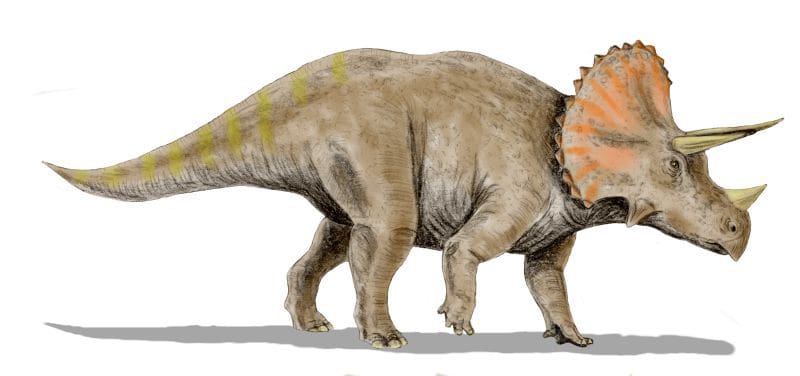
Nobu Tamura (http://spinops.blogspot.com), CC BY-SA 3.0, via Wikimedia Commons
The image of a giant, rhinoceros-like creature with three horns instantly brings to mind dinosaurs, even if you can’t recall its name. This iconic dino is the Triceratops, the most well-known member of a group called Ceratopsians and a popular representative of the entire group.
True to its name, the Triceratops sported three impressive horns on its face – two positioned above its eyes and one on its snout. This plant-eater wasn’t just big, it was also tough, roaming what is now North America during the Late Cretaceous (Mesozoic) period about 155 to 145 million years ago.
It grew to lengths of about 9 meters (30 feet), a height of 2.3 meters (7.5 feet), and weighed 5 to 9 pounds (10,000 – 18,000 lbs).
5. Brachiosaurus
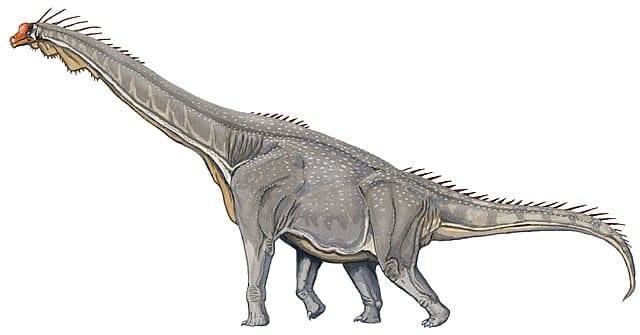
Dmitry Bogdanov, Public domain, via Wikimedia Commons
Towering over the landscape like a living skyscraper, the Brachiosaurus was a superstar of the dinosaur world.
This colossal creature, hailing from North America about 150 million years ago, was once crowned the “biggest dino fossil ever found” when its remains were first unearthed in the 1900s!
A title it has since relinquished. While bigger dinosaurs have since been discovered, the Brachiosaurus still holds its own with its impressive height. Imagine a creature 13 meters (43 feet) tall – that’s taller than a four-story building!
Belonging to the Sauropod group, Brachiosaurus was a gentle giant, munching on plants with its long neck rather than chasing after prey. Its immense size was likely an adaptation for reaching high leaves other dinosaurs couldn’t access.
6. Allosaurus
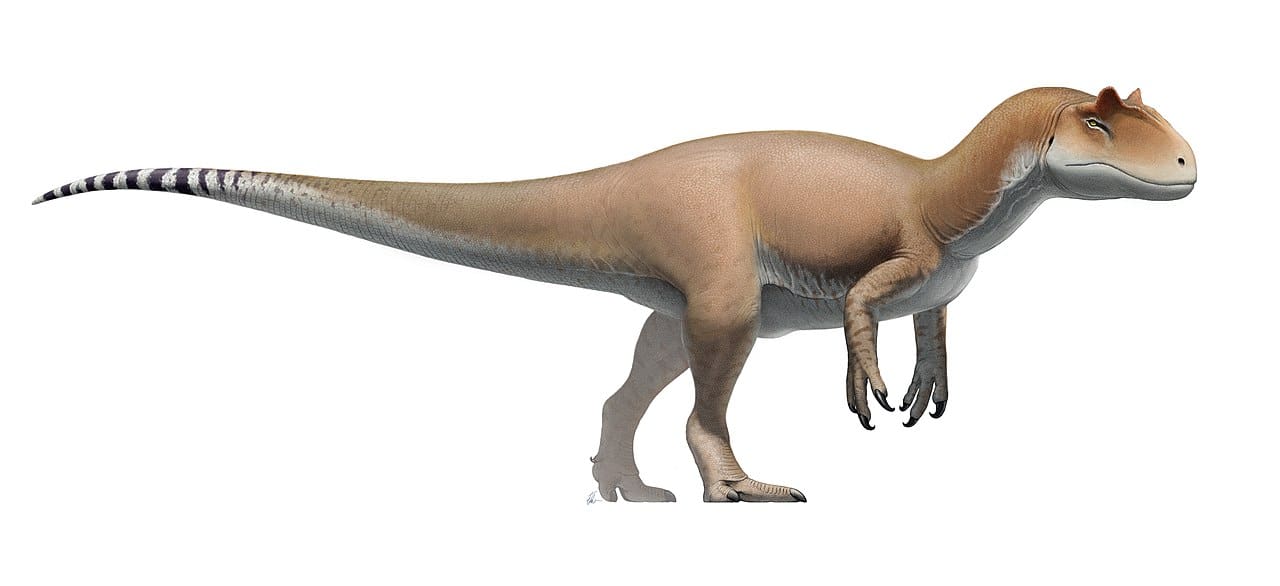
Fred Wierum, CC BY-SA 4.0, via Wikimedia Commons
The Allosaurus, meaning “different lizard,” wasn’t just different, it was downright terrifying! This fearsome carnivore ruled the lands of western North America during the Late Jurassic period, around 150 million years ago.
Imagine a giant, two-legged creature, roughly 30 feet long and weighing up to two tons, with razor-sharp teeth and powerful claws. That’s the Allosaurus!
Thanks to a treasure trove of fossils found in the Morrison Formation, paleontologists know a lot about these prehistoric hunters. They were one of the first theropod dinosaurs (think T-Rex’s relatives) to become well-known, thanks to the famous “Bone Wars” fossil digs of the late 19th century.
Evidence suggests they feasted on large plant-eating dinosaurs like the Stegosaurus and Brachiosaurus, but they might have even gone after other predators too!
7. Diplodocus
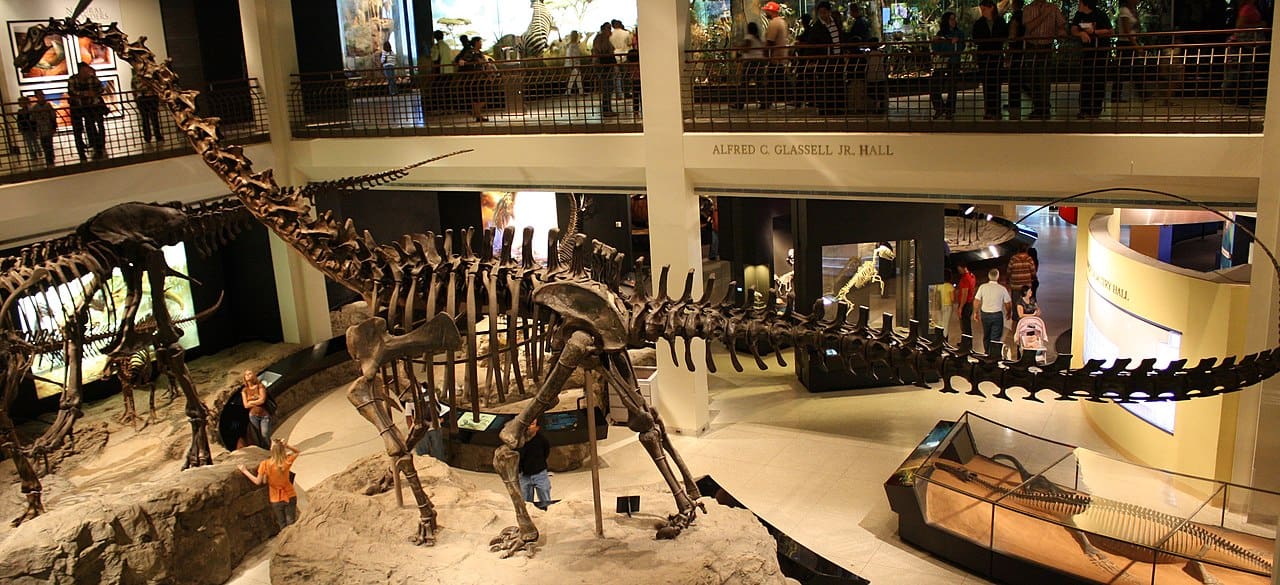
Wikipedia Loves Art participant “The_Wookies”, CC BY 2.5, via Wikimedia Commons
Imagine a dinosaur longer than a school bus! That’s Diplodocus, a giant plant-eater that roamed North America about 150 million years ago.
These gentle giants were the undisputed length champions for many years, with some reaching an incredible 26 meters (85 feet) from snout to tail!
The Diplodocus was also a very heavy creature weighing between 11-18 tons (22,000 – 36,000 lbs). However, size wasn’t their only impressive feature.
Diplodocus also boasted a super long, muscular tail, which scientists believe they swung like a whip to keep hungry predators at bay.
8. Spinosaurus

MartinThoma, CC0, via Wikimedia Commons
The Spinosaurus wasn’t just any dinosaur; it was a giant meat-eater that ruled the Late Cretaceous period, around 99 million years ago. This North African beast was the biggest carnivorous dinosaur ever, even bigger than the Tyrannosaurus rex!
Imagine a crocodile with a dinosaur body, and you’d be close to picturing the Spinosaurus. It had a long, narrow snout and sharp teeth, perfect for catching fish.
However, the most striking feature was the massive sail on its back, taller than most adults! Some scientists think this sail helped regulate its body temperature, while others believe it was used to attract mates.
While it was definitely a hunter, the Spinosaurus, a member of the theropod family, likely spent a lot of time around water, like a supersized crocodile. It probably munched on fish and other aquatic creatures, making it a unique dinosaur unlike any other.
9. Carnotaurus
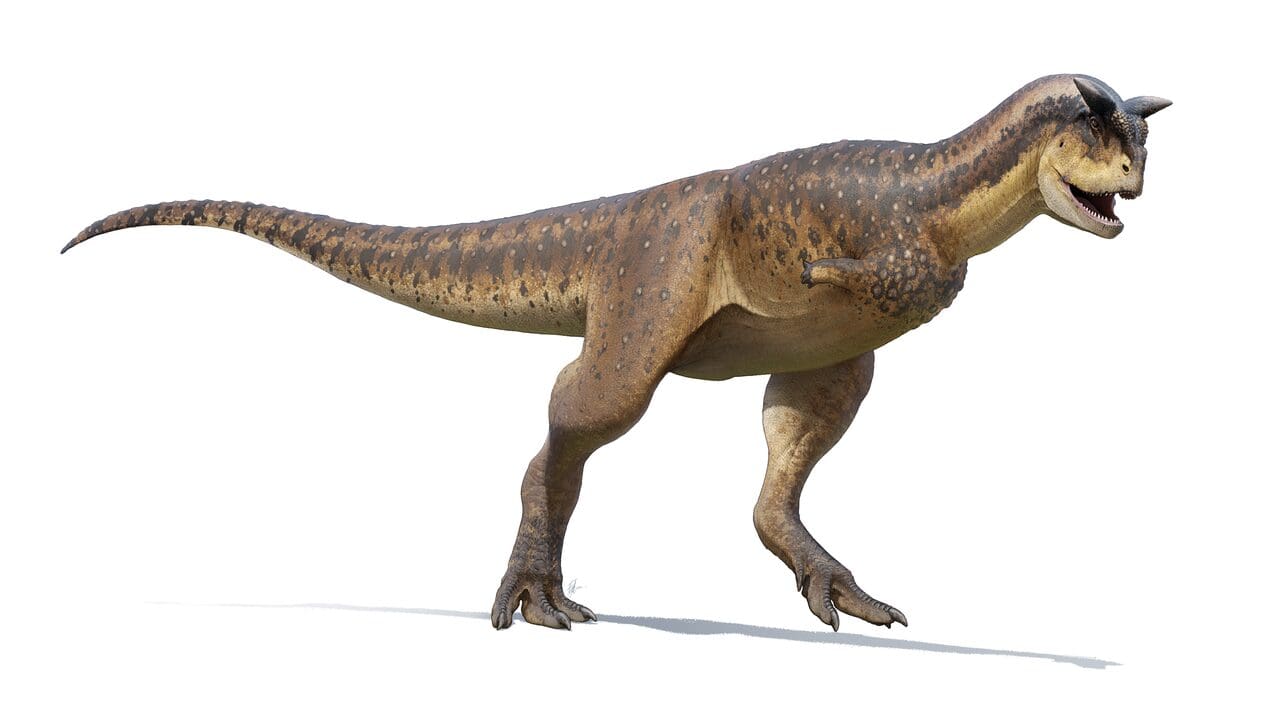
Fred Wierum, CC BY-SA 4.0, via Wikimedia Commons
The Carnotaurus, a carnivorous dinosaur from the Late Cretaceous period (around 70 million years ago), roamed what is now South America.
While it shared the basic theropod body plan – think bipedal with powerful legs and a long tail – what truly set it apart were its horns!
These bony bumps, unique among theropod dinosaurs, jutted out above its eyes, giving it a rather distinctive look.
Despite only one complete Carnotaurus fossil being found so far, scientists have been able to learn a lot about this fascinating creature. This is because the very well-preserved bones provide clues about their size (around 25 feet long), diet (mainly meat), and even skin texture (covered in small scales).
This makes the Carnotaurus one of the best-understood dinosaurs from the Southern Hemisphere, even with just a single fossil specimen!
10. Dilophosaurus
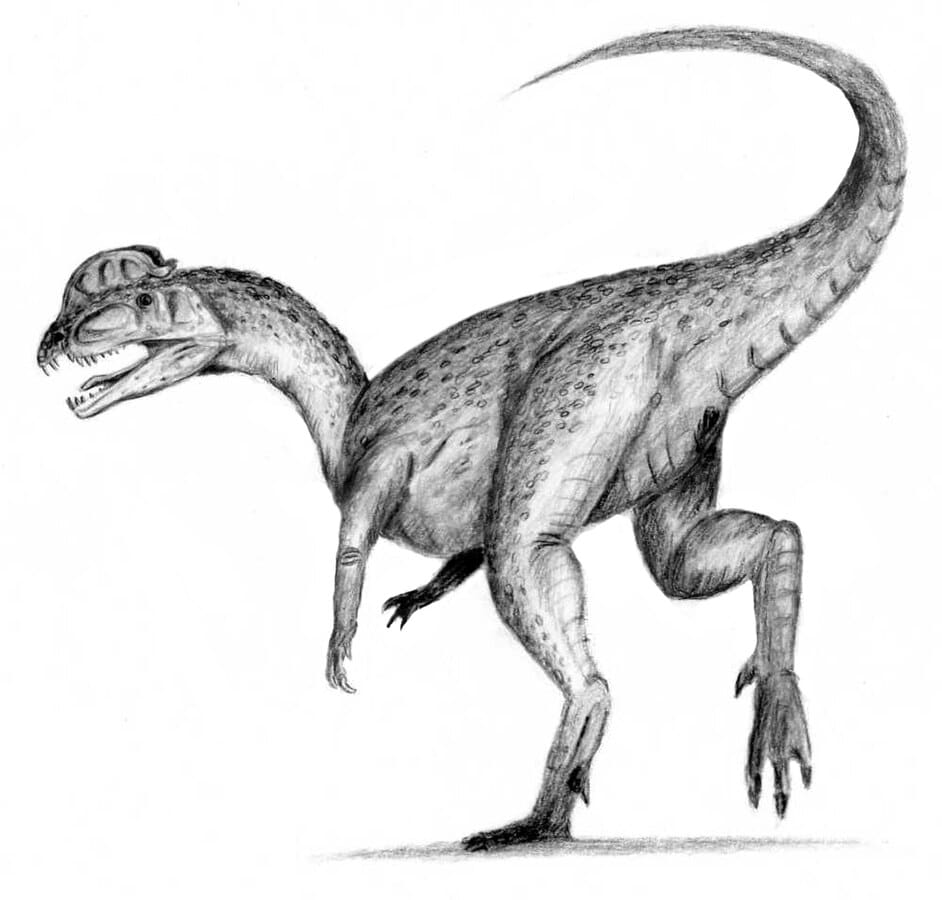
No machine-readable author provided. ArthurWeasley~commonswiki assumed (based on copyright claims)., CC BY-SA 3.0, via Wikimedia Commons
This is yet another dinosaur that has had its perception greatly influenced by the Jurassic Park movies. According to the movie, this dinosaur had extendable neck frills that were capable of spitting venom to paralyze prey.
However, the only true thing about that is that it was a fearsome predator and carnivore. The actual Dilophosaurus was a sleek, agile predator, reaching around 7 meters (23 feet) in length and weighing about 400 kilograms (880 pounds).
Although it lacked Hollywood theatrics, the Dilophosaurus was still a top contender in its ecosystem, thanks to its sharp claws and teeth adapted for hunting prey.
11. Oviraptor
The Oviraptor, whose name ironically means “egg thief,” might be one of the most misunderstood dinosaurs. A true victim of mistaken identity.
Initially labeled a villain for its proximity to a nest upon discovery in 1923 in the southern Mongolian region of Omnogov, this feathered creature from the Late Cretaceous period of Asia has undergone a major image makeover.
Recent evidence suggests the Oviraptor wasn’t a nest-raiding villain, but a dedicated parent who tragically met its end while protecting its own eggs! This discovery makes the Oviraptor a fascinating example of parental care in dinosaurs, a behavior rarely seen in the fossil record.
Despite its small size, this omnivore, measuring around 1.8 meters (6 feet) long, and weighing about 28 kgs (62 lbs), played a crucial role in our understanding of dinosaur family life.
12. Ankylosaurus
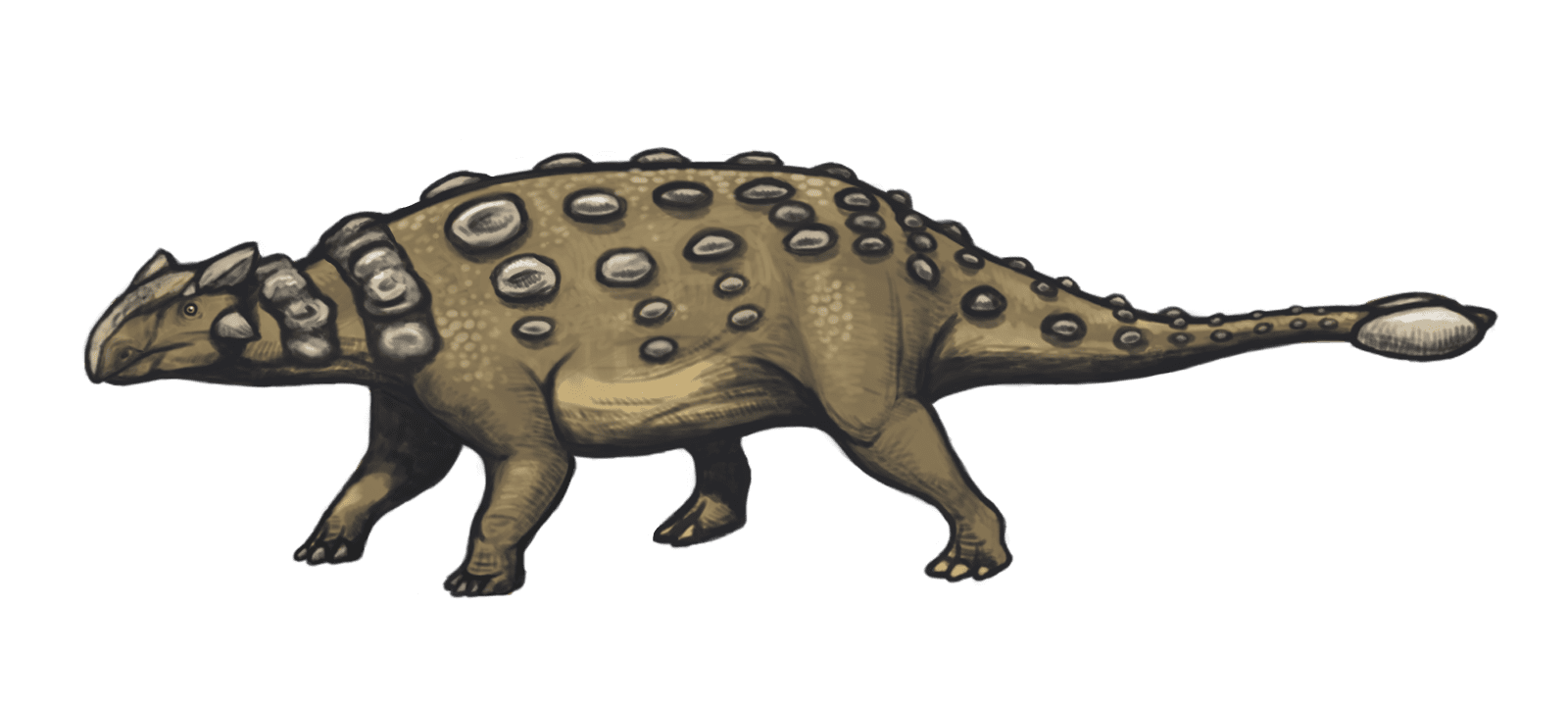
Emily Willoughby (e.deinonychus@gmail.com, http://emilywilloughby.com), CC BY-SA 3.0, via Wikimedia Commons
The Ankylosaurus, with its tank-like armor and clubbed tail, was a real-life dinosaur straight out of a fantasy movie! This heavily armored beast lived around 68 million years ago, during the Late Cretaceous Period, munching on tough plants with its rows of leaf-shaped teeth.
Imagine an 8-meter-long dinosaur, roughly the size of a school bus, covered in bony plates like a living suit of armor! These bony plates, called osteoderms, lined its back and offered incredible protection from predators.
However, the Ankylosaurus, a member of the group Ankylosauridae wasn’t just a walking shield; it also packed a powerful punch (or should we say, tail swing?). Its clubbed tail, strong and heavy, could be swung with impressive force to deter any attacker who dared get too close.
This fearsome combination of armor and weaponry made the Ankylosaurus a true survivor in its prehistoric world.
13. Parasaurolophus
The Parasaurolophus, with its iconic “trumpet” crest, is one of the most recognizable and popular dinosaurs. These duck-billed dinos lived in North America and possibly even Asia during the Late Cretaceous period, around 76 to 66 million years ago.
Despite their herbivorous diet munching on plants, they were far from harmless! Growing up to 30 feet long and weighing up to 2.7 tons (5,952 lbs), they were formidable creatures.
However, what truly sets them apart is their headwear – the bony crest that extended from their snouts and curved backward like a long, hollow tube. This bizarre feature has sparked much debate among scientists.
Some believe it was used like a musical instrument to bellow loud sounds, possibly for communication or attracting mates. Others think it helped them recognize each other or even regulate their body temperature.
14. Argentinosaurus
Back in 1987, Guillermo Heredia stumbled upon the first clue of the mighty Argentinosaurus on his Argentine farm “Las Overas”.
Imagine towering over buildings and weighing as much as 16 elephants! That’s the Argentinosaurus, a giant dinosaur that roamed modern-day South America during the Late Cretaceous period, about 99-89 million years back, and was a true heavyweight champion.
While paleontologists haven’t found a complete Argentinosaurus skeleton, estimates suggest it stretched an incredible 30 meters (100 feet) long, making it the largest dinosaur ever found on the South American continent.
Not only that, but its weight ranged from 65–80 tons (130,000–160,000 lbs) with some suggestions that some could reach a staggering 100 tons, placing it among the biggest land animals to ever walk the Earth!
Think of Argentinosaurus as a gentle giant. Unlike some other dinosaurs, it was a herbivore, munching on leaves and plants rather than hunting other creatures. Its immense size likely helped it avoid predators and reach high foliage for food.
15. Ceratosaurus
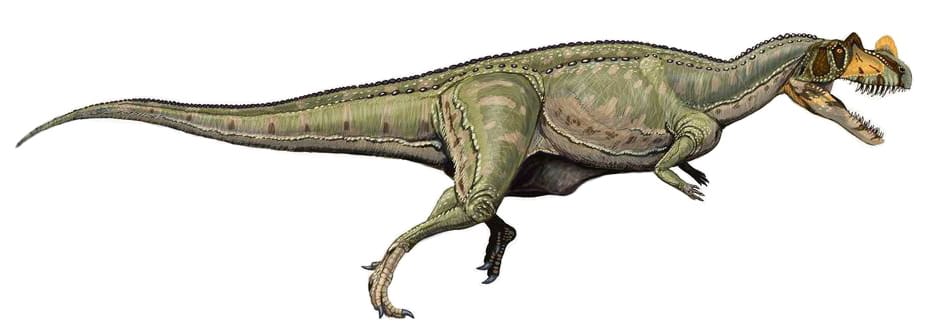
DiBgd at English Wikipedia, CC BY-SA 3.0, via Wikimedia Commons
Roaming North America during the Late Jurassic period, the Ceratosaurus wasn’t the biggest predator on the block, but its unique features and hunting style have made it a popular dinosaur among dino enthusiasts.
Measuring around 17-23 feet (5-7 meters) long, height of about 4 meters (13 feet), and weighing about 2 tons (4,000 lbs), this medium-sized carnivore was likely an agile hunter, thanks to its slender build and powerful legs.
Its most striking feature was the large, bony horn on its snout, which gave it its name (“horned lizard”). While the exact purpose of this horn remains a mystery, scientists believe it may have been used for attracting mates, intimidating rivals, or even head-butting during fights.
Ceratosaurus wasn’t picky about its meals. Its sharp teeth and claws suggest it feasted on a variety of prey, including smaller dinosaurs, reptiles, and maybe even fish lurking in nearby waterways. While not the top dog in its ecosystem, the Ceratosaurus was a well-adapted predator, leaving its mark on the Late Jurassic landscape.
16. Giganotosaurus

ДиБгд, Public domain, via Wikimedia Commons
Giganotosaurus, meaning “giant southern lizard,” lived up to its name! This colossal carnivore ruled the Late Cretaceous period in South America, around 99 million years ago.
Think of it as the top dog of its time, dominating the food chain and facing off against some of the biggest dinosaurs ever, like the gigantic Sauropods.
Measuring up to 43 feet long and weighing around 13 tons, Giganotosaurus was a true heavyweight. Its powerful jaws were lined with sharp, blade-like teeth, perfect for tearing into its prey.
But size wasn’t everything – this predator was also likely fast and agile, making it a formidable hunter.
17. Herrerasaurus
The Herrerasaurus is a slender, two-legged dinosaur that roamed South America around 230 million years ago, during the Triassic Period. This means it predates the T-rex by a couple of million years.
Averaging about 20 feet long and weighing about 350 kgs (770 pounds), the Herrerasaurus is still a bit mysterious. It had features similar to different dinosaur groups, like the giant plant-eaters (sauropods) and meat-eaters (theropods).
This makes it tough for scientists to put a neat label on it, and there’s still debate about exactly what kind of dinosaur it was.
Victorino Herrera discovered the first specimen in Argentina in 1958. The fossil was named after him.
18. Pachycephalosaurus

Fred Wierum, CC BY 4.0, via Wikimedia Commons
The Pachycephalosaurus, meaning “thick-headed lizard,” was a plant-eating dinosaur that roamed North America around 75 million years ago.
The term ‘thick-headed’ is not because it is unintelligent. Well, at least scientists don’t seem to think it was.
This phrase was used to name it thanks to its impressive headgear – a giant, bony dome that could be up to 10 inches (25 cm) thick! While it might seem like a helmet, some scientists believe these domes were actually used for head-butting battles with other Pachycephalosaurus, like a prehistoric boxing match!
The very first Pachycephalosaurus fossil was unearthed in 1859 by Ferdinand Vandeveer Hayden. Found near the Missouri River in the Lance Formation, the specimen was incomplete, consisting only of skull bone fragments.
Unlike other horned dinosaurs, they didn’t have any pointy horns, so their dome served as their main weapon.
19. Microraptor
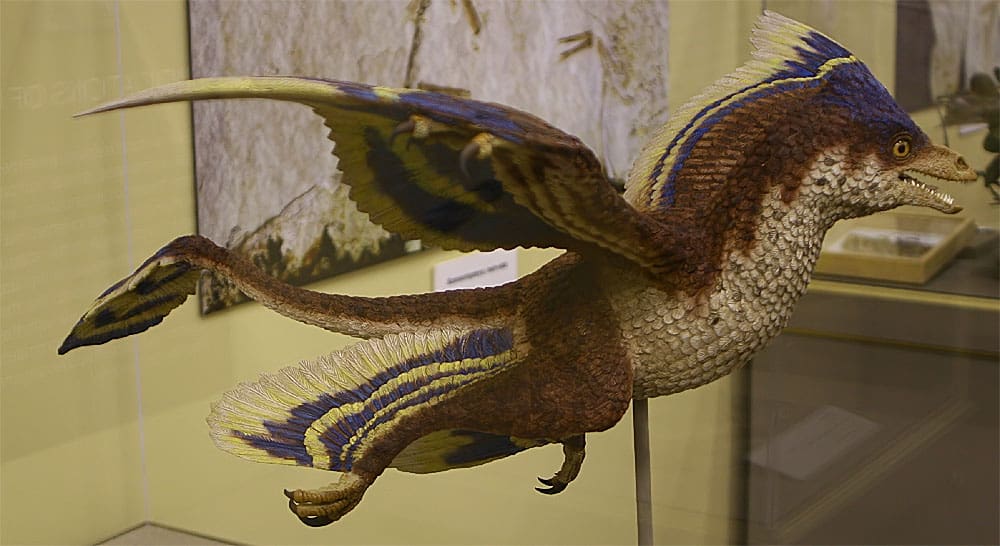
Ocaloa, CC BY-SA 3.0, via Wikimedia Commons
Imagine a dinosaur smaller than a chicken, with not just two, but four wings! That’s the Microraptor, a feathered wonder that lived in Asia around 120 million years ago.
This pint-sized predator, weighing a mere kilogram, was one of the smallest dinosaurs ever discovered! However, don’t underestimate its size; with wings on both its arms and legs, it could glide through the trees like a miniature flying squirrel.
The Microraptor wasn’t just cool, it was also scientifically important. Its feathered body helped scientists understand the connection between dinosaurs and birds.
Just like some modern birds, Microraptor had feathers arranged in wings, suggesting that feathers might have evolved for gliding before true flight took off.
20. Chasmosaurus

Nobu Tamura (http://spinops.blogspot.com), CC BY 3.0, via Wikimedia Commons
Imagine a Triceratops with a bigger, fancier frill and you’ve got the Chasmosaurus! This plant-eating dinosaur lived alongside the Triceratops during the Late Cretaceous period, around 70 million years ago, in what is now North America.
The first discovery was made In 1898 at Berry Creek, Alberta by Lawrence Morris Lambe.
They belonged to the same group of dinosaurs called ceratopsians, known for their horns and frills. Chasmosaurus sported a distinctive frill, much larger and more elaborate than its Triceratops cousin.
This bony crest, unlike the Triceratops’ solid frill, had a big hole in the middle. In fact, the dinosaur’s name means “gap/opening lizard” in reference to this unique feature!
While the exact purpose of the frill and horns is still debated, some scientists believe they were used for display, attracting mates or intimidating rivals by making them appear larger.
Chasmosaurus wasn’t the only dinosaur with this impressive headwear. It belonged to a whole family of frilled dinosaurs called chasmosaurine ceratopsians, all sharing similar features like large brow horns and smaller nose horns compared to their Triceratops relatives.
21. Deinonychus
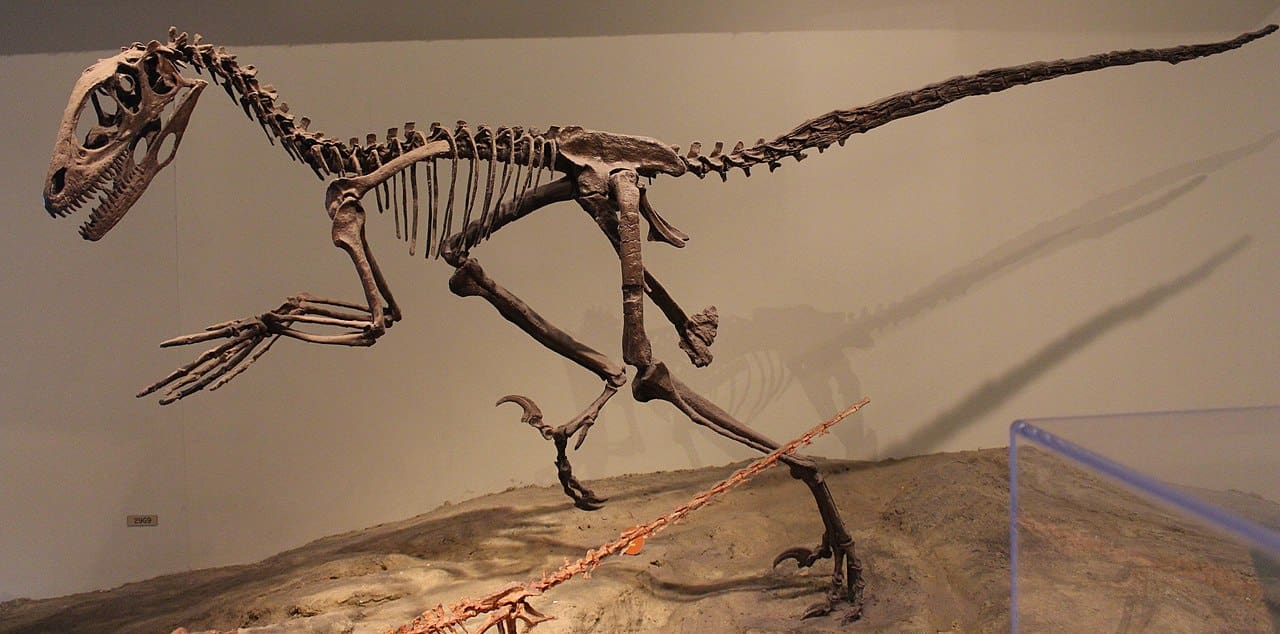
Jonathan Chen, CC BY-SA 4.0, via Wikimedia Commons
Imagine the Velociraptor, but bigger and even more terrifying! That’s Deinonychus. A feathered predator that lived in North America about 115 to 108 million years ago.
This speedy meat-eater wasn’t just big, it was also quite clever, using its sharp, curved claws to take down prey.
This dinosaur discovery in Southern Montana by John Ostrom and Grant Meyer in 1964 altered our perception of dinosaurs, portraying them as agile and active creatures rather than slow and lumbering. As a carnivorous dinosaur, Deinonychus relied on its hunting prowess, utilizing its distinctive claws.
The name Deinonychus translates to “Terrible claw”, a fitting name due to its large and menacing claws.
22. Megalosaurus
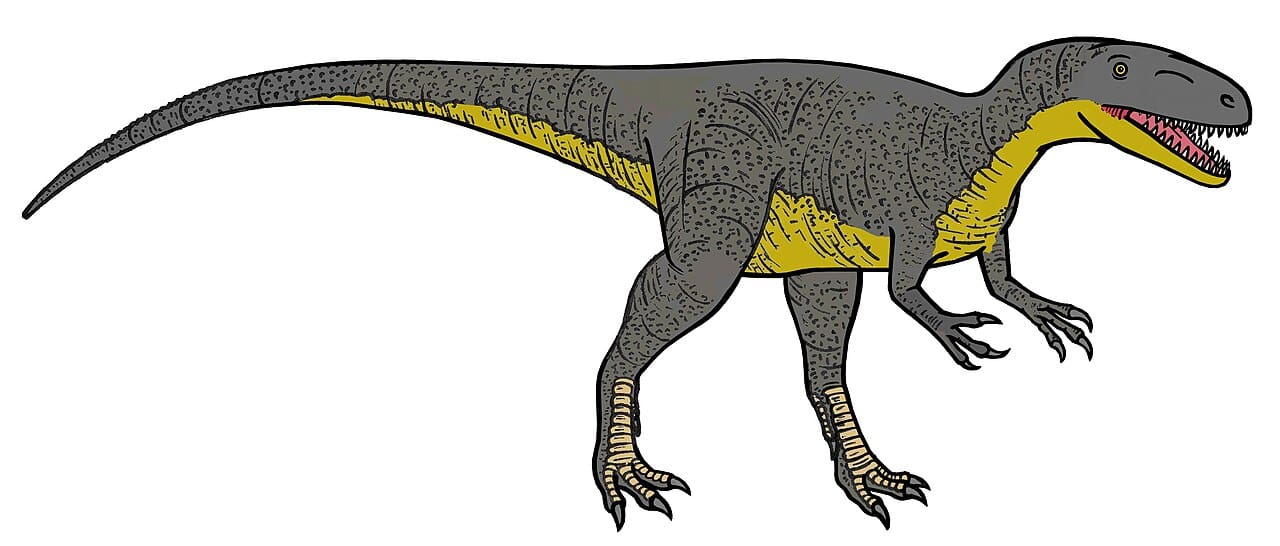
Conty, CC BY-SA 3.0, via Wikimedia Commons
The Megalosaurus was one of the first dinos ever discovered and was alive around Europe about 166 million years ago. It was a top predator during its time and grew to about 30 feet long.
Think of it as a giant ancestor of T. Rex, with sharp teeth and powerful legs built for chasing prey. Megalosaurus lived during the Middle Jurassic period, which means it shared the Earth with some pretty amazing creatures like the long-necked sauropods and armored stegosaurs.
23. Iguanodon
During discovery, paleontologists believed that the discovered tooth fossil was that of an extinct giant Iguana. Therefore, the animal was named Iguanodon which translates to “iguana tooth”.
However, since then it has been discovered that the creature is not closely related to the Iguana. The Iguanodon was a plant-eating behemoth that roamed the Earth during the Early Cretaceous period, about 140 to 100 million years ago.
Fossils of this dinosaur were among the first discovered, way back in 1825 in Europe! It was the size of an African elephant, but twice as heavy.
This bulky dinosaur could walk on all fours like a hippo, but it was also flexible enough to switch to walking on two legs when needed.
Despite the iguana part of its name, the Iguanodon had no relation to modern lizards and instead belonged to a group of plant-eating dinosaurs called iguanodontids.
These gentle giants munched on leaves and ferns, using their unique thumbs with sharp spikes for defense against predators.
24. Gallimimus

Steveoc 86, CC BY-SA 3.0, via Wikimedia Commons
The Gallimimus, meaning “chicken mimic,” was a non-feathered dinosaur. This Late Cretaceous dinosaur, was strutting around Asia roughly 70 million years ago.
Reaching up to 6 meters (20 feet) long and weighing around 400 kilograms (880 pounds), it was the largest member of its group, the ornithomimids.
Unlike its name might suggest, the Gallimimus didn’t actually mimic chickens. Instead, it was an omnivore, feasting on a diverse menu of insects, lizards, small mammals, and even fruits.
Its slender build, long legs, and ostrich-like feet and neck made it a swift runner, perfect for snatching prey or escaping larger predators.
The first Gallimimus fossils were unearthed in the Gobi Desert of Mongolia during the 1960s, offering a glimpse into the diverse fauna of this ancient ecosystem. Scientists were particularly intrigued by the skull, which lacked teeth and sported a large, toothless beak, suggesting a scavenging or opportunistic feeding style.
Despite its lack of teeth, the Gallimimus possessed some intriguing features. Its three-toed feet were tipped with sharp claws, potentially used for digging or defense.
25. Compsognathus
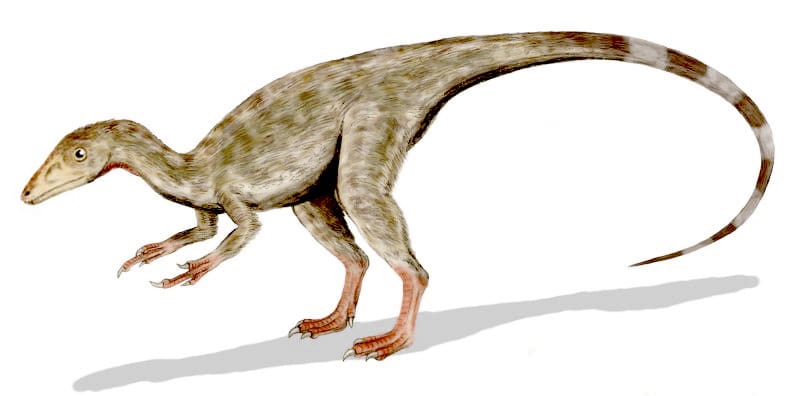
Nobu Tamura (http://spinops.blogspot.com), CC BY-SA 3.0, via Wikimedia Commons
The Compsognathus wasn’t your average dinosaur. Imagine a chicken, but even smaller, measuring just about 2-3 feet long from beak to tail. This pint-sized predator scurried around during the Late Jurassic period, about 150 million years ago, in what is now Europe.
Despite its size, the Compsognathus was a fierce carnivore, likely snacking on lizards, insects, and maybe even small mammals.
Fossils of this dinosaur were first discovered in Germany in the 1850s, making it one of the first small theropods (two-legged, meat-eating dinosaurs) ever found.
Scientists even found a tiny fossilized skeleton inside one Compsognathus, suggesting it might have dined on lizards!
The Compsognathus, whose name means “elegant jaw”, didn’t have any close living relatives. Instead, it belonged to a unique group of theropods called compsognathids, known for their small size and agile bodies.
So, there you have it, a whirlwind tour through the Jurassic jungle and Cretaceous canyons, meeting 25 of the most captivating dinosaurs to ever roam the Earth.
However, remember, this is just a glimpse into the incredible diversity of dinosaurs that once thrived. Countless more species await discovery, their stories waiting to be unearthed from the fossil record.
Planning a trip to Paris ? Get ready !
These are Amazon’s best-selling travel products that you may need for coming to Paris.
Bookstore
- The best travel book : Rick Steves – Paris 2023 – Learn more here
- Fodor’s Paris 2024 – Learn more here
Travel Gear
- Venture Pal Lightweight Backpack – Learn more here
- Samsonite Winfield 2 28″ Luggage – Learn more here
- Swig Savvy’s Stainless Steel Insulated Water Bottle – Learn more here
Check Amazon’s best-seller list for the most popular travel accessories. We sometimes read this list just to find out what new travel products people are buying.





